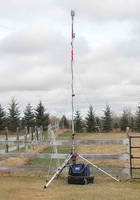Weather Data for Noise Monitoring

"Weather conditions are the single largest variable factor in how sound travels over large distances," says Steve Bilawchuk principal partner and engineer at ACI Acoustical Consultants Inc. "Wind speed and wind direction are of crucial importance. " ACI is an acoustical engineering consulting company based in Alberta, Canada, which uses Orion LX Weather Stations from Columbia Weather Systems in their services of conducting environmental noise monitoring for things like road noise, rail noise, and industrial noise.Â
"In addition to the noise monitoring data, we also need the local weather data for the duration of noise monitoring period. Having a portable weather monitoring station gives us the flexibility to set up wherever we need and gives us very localized data. The equipment is typically set-up, locked, and left to run un-attended in the field for as little as 24-hours and as long as a few months at any one location."
Listing the key features and parameters for this application, Steve notes:
• Wind speed, wind direction, temperature, relative humidity, barometric pressure, rain.
• No moving parts. Our older weather monitors have spinning anemometers and wind vanes which can freeze in place in a thick foggy frost.
• Large data storage capacity. We only use these for perhaps 50 – 100 days per year. With a 2 GB card, we will likely never fill-up the memory for the entire life of these units.
• Remote access via cellular modem. Our equipment is often installed at locations very far from our office (1 or 2 days drive) so having the ability to see the real-time weather and to download the logged weather remotely is critical to us.
• Operates on 12VDC. All of our remote equipment needs batteries to operate and 12VDC is the easiest and most common with regards to batteries, fuses, switches, etc.
"When we conducted a search, the unit available from Columbia Weather Systems was the only one that met all of our criteria. " ACI built a custom mast and storage case configuration that houses all the components including batteries, charger, and cellular modem. Solar panels are utilized for longer installations.
"Once the weather monitor is setup in the field, it simply logs continuously and then we check on it remotely from time-to-time. The units each have remote access via cellular modem, so we just use our smart phones while we are in the field to ensure that everything is running properly and then we use our computers in the office to check the units periodically and download the logged data. At the end of the project, we download the data and analyze it on custom software using Matlab."
Based in Hillsboro, Oregon, Columbia Weather Systems provides weather stations for environmental monitoring applications in industrial and government applications worldwide.
www.columbiaweather.com




